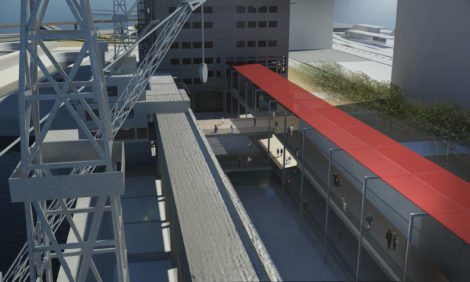Category: Competitions & Awards
Competitions
& Awards
Hellenic Institute of Architecture 6th Biennale
Two of our projects were distinguished
among the 450 entries:
Retail Building in Psychiko, Athens, 2007
Nikopolis Research Center, Nikopolis, 2009
Association of Greek Architects
11th Congress Awards
Mention received for
Retail Building in Psychiko, Athens, 2007
Piraeus Cultural Coast
National Museum of Underwater Antiquities
International architectural competition for the Redesign and Conversion of the 1930’s Piraeus “Silo” warehouse complex into a Museum of Underwater Antiquities, organized by the Port Authority of Piraeus and the Greek Ministry of Culture
www.piraeusculturalcoast.org.gr
Honorary prize awarded
The key to confronting the main challenge of the project -enhancement of the historic building vs particular new use- was to be found in the original qualities of the building itself. Inspiration derived from the economy of its design, as well as the notion of conveyance which governs the old warehouse building and the entire area of the port.
The building’s impressive silhouette and its industrial style are to be maintained. Interventions to the external shell are kept to a minimum. The ground floor’s outer stonewalls are removed allowing public space to flow under the building, while a linear window, that runs along the top floor’s facades, is to reflect the new use.
An important compositional aspect is the integration of a second corridor-building, which stretches out parallel to the original conveyor wing and cuts through the main building, facilitating the circulation of visitors, thus handling the new “conveyance” needs. Materials used on this new component are selected to contrast with the old structure, highlighting the intervention.
The ground floor pilotis serves as an intermediate space before entering the main reception areas, which are to be located on the first floor. Without any specific use, the pilotis’s surface is now to be covered by water, except, of course, for the circulation corridors which lead to the main entrance.
On the first floor, the existing open-plan space, is utilized to host the museum’s reception hall, enhanced by public facilities, such as the museum store, the library, and a multi-purpose hall and theatre. This spacious indoor “piazza“ is also connected to the southern courtyard’s outdoor areas via the new corridor building stretching towards the waterfront.
On top of the reception floors, the prevailing volume of the silos’ block will now host the museum’s main exhibition areas. In here, modifications cannot but be extensive, so as to meet the new needs. However, the new arrangements follow existing grid lines and stay in tune with the old structure. Finally, the neat layout of the museum’s exhibition areas, supported by an equally flexible design of the air-conditioning installations, offers flexibility and also allows for a future addition. The building can easily be extended towards the north, as simply as it was done once before in the past. The simplicity of the original concept is maintained.
Linear mechanical “conveyance” is adopted again, this time for the circulation of visitors. Adjoining a large longitudinal wall that belongs to the old structure and stretches through the entire length of the building, a sequence of escalators conveys people directly to the top floor of the exhibition areas. Visitors will then be channeled downwards, in a course that coils around this main internal wall, and opens into exhibition halls of varied heights, which are arranged on both sides.
Arrangements to incorporate different uses into the museum are kept in accordance to the existing structural order. Administration areas are fitted within the former office wing, whereas the old building’s distinctive top floor structure will appropriately house the cafeteria and restaurant facilities to take advantage of the spectacular views. The clock tower will once again undertake direct “conveyance” of visitors from the reception areas to the top floor via elevators, but will also offer the ability to view the building’s former function (by being a central part of it). An exhibit of the old facilities continues into the old conveyor-corridor. The crane towers are also incorporated into the new museum’s various uses.
Everywhere within the museum, the new use is being enriched, rather than restrained, by the weaving of the building’s former life, which is being brought into focus, or not, depending on the specific needs of each area.
Supplementary areas needed are grouped on an underground floor, which expands under the museums southern outdoor space. Here, workshops and offices are lined up on both sides of a linear and lowered courtyard, which expands towards the sea to form a water canal. A building that bridges over the canal connects the old conveyor building to the new one and houses a coffee-bar with views to the sea and direct access to outdoor spaces.
The design of outdoor areas and the surrounding public park also shares the prevailing linearity, as well as the industrial style of the museum’s architecture.
Design Team
architects
Stelios Oikonomidis-Doumpas
Agis Oikonomidis-Doumpas
Elena Kouri
Leto Koumantaraki
George Criparacos
Theodora Tsoumi
Danai Melessidou
Panita Karamanea
consultants
Manos Kyriazis, civil engineer
Vasilis Kolovos, m. engineer
Athanasios Danilov, lighting architect
Anastasia Kalou, exhibition designer
Piraeus Tower 2010
Changing the Face/Façades Reformation
International Competition – “greekarchitects.gr”
Date: June 2010
B’ mention among 4 prizes and 8 mentions
(380 entries from 44 different countries)
Design team
Agis Oikonomidis-Doumpas
Stelios Oikonomidis-Doumpas
Anastasia Chronopoulou
Athena Papadopoulou




























